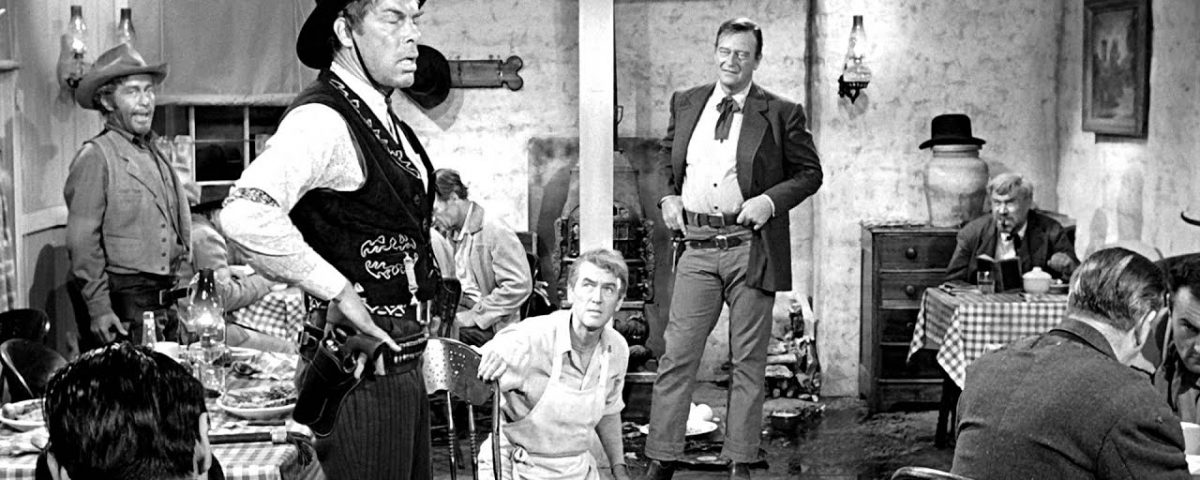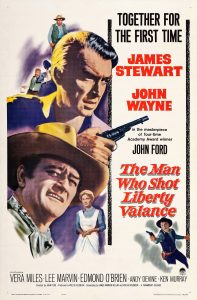The BEST: The Man Who Shot Liberty Valance

 Summary: In The Man Who Shot Liberty Valance the great Hollywood director John Ford takes on yet another Western, featuring (who else?) the incomparable John Wayne playing a familiar rugged, straight-talking cowboy, Tom Doniphon. The setting is Shinbone, a frontier town in an unnamed territory on the cusp of statehood. This modest town, populated by a simple, but diverse group of hardworking frontiersmen and women, is intermittently harassed by the sadistic whip-cracking, Liberty Valance, played by Lee Marvin, who fears no one, except perhaps Doniphon. Enter a newly minted, idealistic lawyer from the north, Ransom Stoddard, played by the legendary James Stewart, who intends to bring both law and education to this backwater town. The title reveals Liberty Valance’s ultimate fate; yet it is in how he meets that fate that the dramatic tension resides.
Summary: In The Man Who Shot Liberty Valance the great Hollywood director John Ford takes on yet another Western, featuring (who else?) the incomparable John Wayne playing a familiar rugged, straight-talking cowboy, Tom Doniphon. The setting is Shinbone, a frontier town in an unnamed territory on the cusp of statehood. This modest town, populated by a simple, but diverse group of hardworking frontiersmen and women, is intermittently harassed by the sadistic whip-cracking, Liberty Valance, played by Lee Marvin, who fears no one, except perhaps Doniphon. Enter a newly minted, idealistic lawyer from the north, Ransom Stoddard, played by the legendary James Stewart, who intends to bring both law and education to this backwater town. The title reveals Liberty Valance’s ultimate fate; yet it is in how he meets that fate that the dramatic tension resides.
Why this is The BEST: Director John Ford transcends and perhaps breaks the Western genre he invented. Absent are the signature horse chases and shootouts. He eschews the expansive visuals of the American plains and the grand ranches for which he was known in favor of a modest studio set. Though color was available, Ford chose to shoot in basic black and white, underscoring the subtle tragedy that lurks in the background of the story. The heroes and villains are still there, but they are complicated, flawed characters whose unique personalities are drawn by tightly directed scenes and sharp dialogue. Marvin plays the villain with gleeful wickedness that has the audience pining for that moment when he falls. Two men vie for the title of hero and the hand of the fair damsel. Doniphon in his boots and chaps, packing the usual six-shooter, willfully stands against Valance’s intimidations. Wayne’s cowboy swagger and grit are on full display, but it is complicated by simplicity and vulnerability. Stewart’s Stoddard inspires with his eloquence and puts on a show of great bravery, yet simultaneously expresses a physical weakness and naiveté that has us questioning his ability to come through at the end.
Who will take this villain down? The question is more than melodrama, but cuts to the very nature of heroism. Is the hero the lone cowboy who stands up to villainy or the thoughtful orator who can inspire others? Is it brawn or brains that will fell this criminal? Classic Western scenes –- the saloon, the ranch, the dusty abandoned street – contrast the cowboy Doniphon with the lawyer Stoddard, their reactions and interactions conflict, contrast, complement, and sometimes even agree, highlighting the complex definition of the hero that seems biblical. Heroes are exceptional human beings, possessing great qualities and strengths, inspiring and yet limited, at times, even flawed. The Torah, R. Shimshon R. Hirsch notes (commentary to Gen. 25:27), does not hide from us the flaws of our great men and women. Instead, it speaks of them honestly and, in doing so they become more real and emulatable. Their accomplishments are that much more inspiring.
In this “novel” Western, Ford confronts the conflicting personalities and ideals upon which the United States was formed. On one side, we have Doniphon, the frontiersman and cowboy, the settler of the west. He has no time for long-winded discussion or debates over policy. It was this stripped down pragmatic worldview that laid the foundation for towns like Shinbone which would grow into the great American metropolises. On the other side is the idealist and eloquent Stoddard, at one time struggling to find a place in this lawless town and at the same time trying to transform it into a lawful one. He seeks to write the future of Shinbone.
Is this not the challenge of Jewish history? Our success is founded upon an intricate intellectual history of debate and creative thought. Yet, at the same time, the Jewish people move forward due to the sacrifices of those who lived their ideas through daily commitments and immense self-sacrifice. Most recently, the State of Israel was founded, less by Zionists thinkers, than by soldiers and farmers— “Sabra Donipnons” — who sacrificed and labored in the fields. The mature contemporary state now looks to scientists, technologists, and policy wonks — “Hebrew speaking Stoddards” — to secure its future. The challenge is keeping these two sets of builders in perpetual conversation.
Ford’s heroes remind us that the two visions are complementary and consequential in creating a successful future. Evil is defeated. Success is achieved when John Wayne and James Stewart dialogue with and ultimately respect one another. This compromise and interplay is what makes The Man Who Shot Liberty Valance, a classic film and truly “the best.”
Elie Weissman is the Rabbi of the Young Israel of Plainview and teaches at Yeshiva University High School for Girls.
Click here to read about “The BEST” and here to see the index of all columns in this series.
